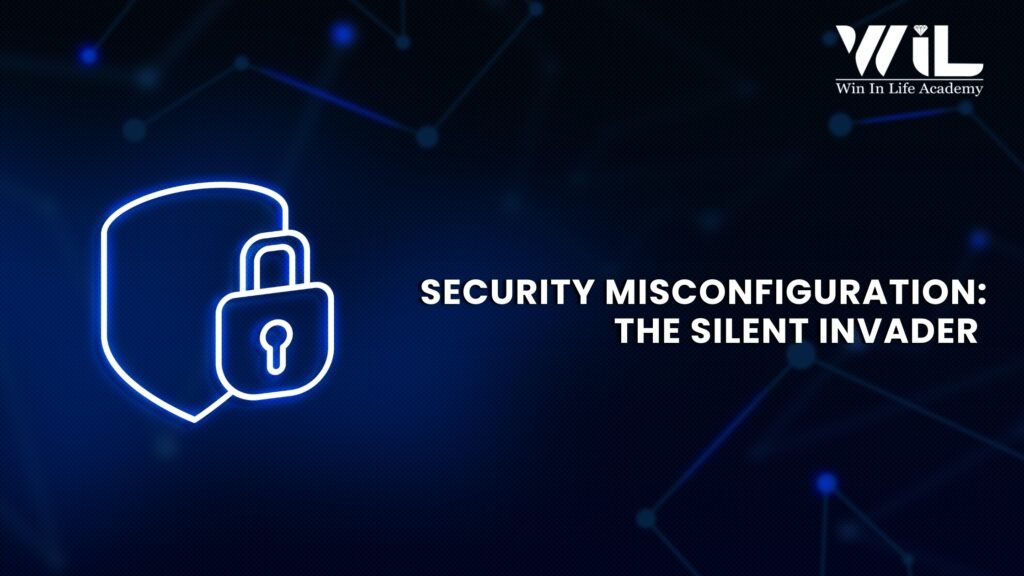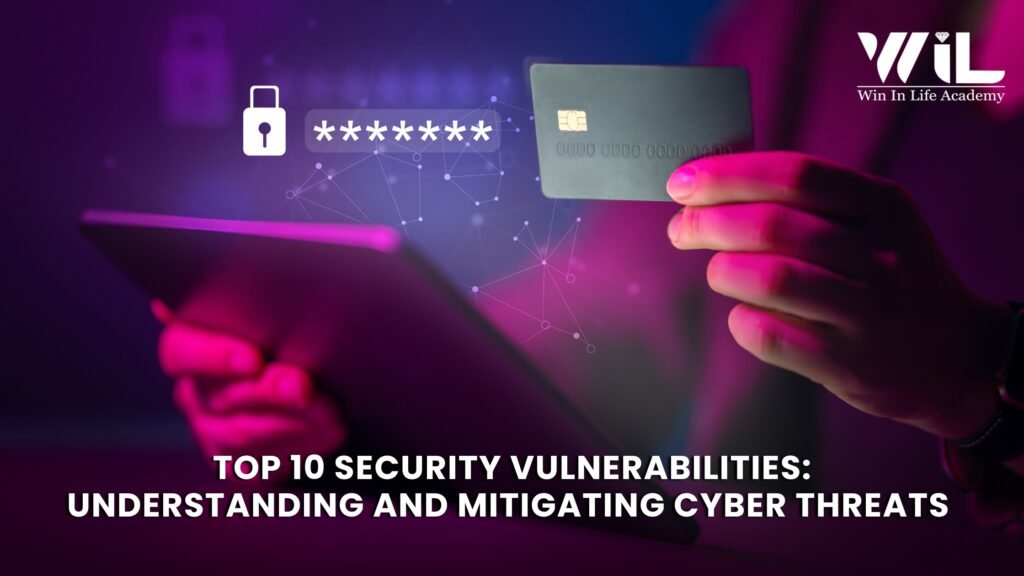In an era where cybersecurity breaches are becoming increasingly sophisticated, ethical hacking has emerged as a vital strategy for identifying and mitigating vulnerabilities. By simulating real-world cyberattacks, ethical hackers uncover weaknesses before malicious actors can exploit them. This blog post delves into the top eight security vulnerabilities and how ethical hacking techniques can help organizations fortify their defenses. If you are pursuing a cybersecurity course or hacking course, mastering these vulnerabilities is essential for becoming a proficient ethical hacker.
Scroll down to read more about all the security vulnerabilities in cyber security.
Security Misconfiguration: The Silent Invader

Security misconfiguration refers to incorrect or incomplete security settings in software, network devices, or web servers. It may involve unpatched systems, default credentials, or excessive permissions, all of which open avenues for cyberattacks. These vulnerabilities increase the attack surface for threat actors to exploit. Ethical hackers systematically identify and remediate misconfigurations by conducting security audits and penetration tests.
Security misconfiguration occurs when system or application settings are poorly configured, or essential security measures are absent. This makes systems highly vulnerable to attacks.
Common Examples and Risks:
- Unpatched Systems: Outdated systems are susceptible to known exploits.
- Default Credentials: Widely known default usernames and passwords make systems easy to breach.
- Insecure Communications: Unencrypted data transmission exposes sensitive information.
- Excessive Permissions: Granting unnecessary access rights increases internal threat risks.
Mitigation Through Ethical Hacking
Ethical hackers perform rigorous configuration assessments to identify and rectify misconfigurations. They also recommend best practices for cloud, application, and network configurations to reduce exposure.
Enroll for: Ethical Hacking Training
2. Injection Attacks: Manipulating System Inputs
Injection attacks occur when invalidated user input is processed as part of system commands or database queries. Attackers can execute arbitrary code or access unauthorized data by exploiting input fields in applications. Examples include SQL, LDAP, and command injections, which compromise data integrity and system functionality. Ethical hackers simulate such attacks to identify weak input validation and enforce secure coding practices.
Injection attacks occur when attackers exploit input vulnerabilities to insert malicious code into an application. This can lead to unauthorized data access or full system compromise.
Types of Injection Attacks:
- SQL Injection: Manipulates SQL queries to gain unauthorized access to databases.
- Command Injection: Executes arbitrary commands on the host system.
- XML Injection: Alters XML processing to manipulate application logic.
Ethical Hacking in Action
Injection attacks occur when invalidated user input is processed as part of system commands or database queries. Attackers can execute arbitrary code or access unauthorized data by exploiting input fields in applications. Examples include SQL, LDAP, and command injections, which compromise data integrity and system functionality. Ethical hackers simulate such attacks to identify weak input validation and enforce secure coding practices.
3. Vulnerable Components: Weak Links in the Chain
Old, inadequate, or poorly designed components such as third-party libraries, frameworks, and methods embedded within the code can introduce vulnerabilities. These components may harbor known security flaws, bugs, or weaknesses that attackers can exploit to bypass access controls, execute malicious code, or compromise overall system integrity.
Outdated or unmaintained applications are particularly susceptible to attacks if not promptly updated or replaced. Threats can range from data breaches and system hijacking to distributed denial-of-service attacks and other malicious activities, posing significant risks to system security.
The Risk of Outdated or Improper Components
Third-party libraries, frameworks, and plugins can introduce vulnerabilities if outdated or misconfigured.
Key Vulnerability Types:
- Remote Code Execution (RCE): Enables attackers to execute malicious code.
- Cross-Site Scripting (XSS): Embeds malicious scripts in web pages, stealing credentials or hijacking user sessions.
How Ethical Hackers Mitigate Risks
Ethical hackers conduct component vulnerability scans, ensuring timely updates and security patches are applied to all software components.
Read our blog post on: Unlock Your Earning Potential: Lucrative Career paths for Ethical Hackers
4. Social Engineering: Manipulating Human Behavior

Social engineering manipulates human behavior to extract sensitive information, bypassing technical controls. Attack vectors include phishing (fraudulent emails), baiting (malicious downloads), and pretexting (posing as a trusted authority). These tactics exploit cognitive biases and trust. Ethical hackers conduct social engineering simulations to increase employee awareness and resilience to manipulation. Social engineering attacks exploit human psychology to deceive users into compromising sensitive information or systems.
Common Social Engineering Tactics:
- Phishing: Emails designed to trick users into revealing credentials.
- Baiting: Fake offers lure victims into downloading malware.
- Pretexting: Impersonates authority figures to extract sensitive information.
Defensive Strategies via Ethical Hacking
Authentication Vulnerabilities: Weak Entry Points
Authentication vulnerabilities stem from weak, broken, or improperly implemented authentication mechanisms. Common issues include the use of weak passwords, missing multi-factor authentication (MFA), and lack of protection against brute-force attacks. Such flaws can lead to unauthorized system access. Ethical hackers perform authentication tests and recommend strong password policies and MFA implementation to mitigate risks.
Flaws in Authentication Systems
Authentication vulnerabilities occur when login mechanisms fail to prevent unauthorized access.
Common Issues:
- Weak Credentials: Easily guessable or reused passwords.
- Lack of MFA: Absence of multi-factor authentication (MFA) increases risks.
- Brute-Force Susceptibility: Systems without brute-force protection are vulnerable to repeated login attempts.
Ethical Hacking Solutions
Ethical hackers test authentication mechanisms, enforce robust password policies, and implement MFA to strengthen access controls.
6. Insider Threats: Trusted but Dangerous
Insider threats occur when individuals with authorized access misuse their privileges to compromise organizational security. These threats can be malicious (intentional theft or sabotage) or negligent (carelessness or human error). Insider espionage for competitive gain is another potential risk. Ethical hackers identify high-risk insiders and recommend role-based access controls (RBAC) and behavioral monitoring to reduce insider threats.
Insider threats involve employees or other insiders abusing their access privileges to compromise sensitive information or systems.
Categories of Insider Threats:
- Malicious Insiders: Deliberately steal or sabotage data.
- Negligent Insiders: Carelessly compromise security.
- Insider Espionage: Leaks sensitive data for competitive advantage.
Ethical Hacking Approaches
Ethical hackers identify potential insider threats through vulnerability assessments and recommend role-based access control (RBAC) to limit unauthorized actions.
7. Sensitive Data Exposure: Unintended Leaks
Sensitive data exposure arises when confidential information—such as personal, financial, or health data—is inadequately protected. Improper encryption, insecure storage, or unprotected transmission channels are typical causes. This can lead to large-scale data breaches, such as the Equifax breach of 2017. Ethical hackers review encryption protocols, data storage practices, and network communications to ensure secure data management.
The Scope of Sensitive Data Exposure occurs when sensitive information is not adequately protected, leading to unauthorized access or theft.
Real-World Example:
The Equifax breach in 2017 exposed millions of users’ personal and financial data due to a vulnerability and expired encryption certificates.
Ethical Hacking Measures
Ethical hackers assess encryption protocols and storage practices to safeguard sensitive data. They also recommend secure communication channels and data retention policies.
8. Injection Flaws: Compromising Web Applications
Injection flaws occur when applications allow user input to manipulate queries or commands without proper validation. These flaws are commonly seen in SQL injection, LDAP injection, and XML injection, allowing attackers to access, modify, or delete sensitive data. Ethical hackers conduct thorough input validation checks and promote safe coding practices to eliminate injection points. Injection flaws allow attackers to inject malicious code through web application input fields.
Notable Injection Types:
- SQL Injection: Tampering with database queries.
- LDAP Injection: Manipulating directory queries for unauthorized access.
- XML Injection: Modifying XML data to bypass authentication or manipulate data.
Ethical Hacking Interventions
Ethical hackers conduct penetration testing to uncover and remediate injection flaws, promoting secure input validation practices.
9. Shared Tenancy Vulnerabilities: Cloud Security Risks

Shared tenancy vulnerabilities exist in multi-tenant cloud environments where resources are shared across multiple users or organizations. If one tenant is compromised, attackers can move laterally across the shared environment. Ethical hackers assess tenant isolation, implement network segmentation, and monitor cloud configurations to prevent cross-tenant attacks, enhancing the security of cloud infrastructures. Shared tenancy refers to multiple organizations using the same cloud infrastructure. If one tenant is compromised, others may be affected.
Mitigation Through Ethical Hacking
Ethical hackers assess cloud environments for shared tenancy risks and recommend network segmentation to isolate data and minimize lateral movement.
10. Insider Curiosity: Unintentional Data Exposure
Insider curiosity refers to scenarios where employees or other internal users access sensitive information out of mere curiosity rather than malicious intent. While these actions may seem harmless, they can inadvertently lead to data exposure, privacy violations, and compliance breaches.
Curious insiders often access files or databases beyond their job responsibilities, potentially exposing sensitive customer information, proprietary business data, or trade secrets.
One of the key risks of insider curiosity is the unintentional dissemination of sensitive data. For instance, an employee may download or share confidential information without realizing its security implications.
To mitigate this risk, cybersecurity teams employ strategies like Role-Based Access Control (RBAC) to limit access strictly to job-relevant data. Regular access audits, logging, and monitoring are very helpful to identify and address instances of unauthorized data access. Ethical hackers also play a role by conducting vulnerability assessments and recommending robust access management policies to minimize data leakage from insider curiosity. By fostering a strong security awareness culture, organizations can reduce the likelihood of unintentional data exposure.
Conclusion
Ethical hacking is indispensable in today’s cybersecurity landscape. By identifying vulnerabilities across various attack vectors, ethical hackers play a pivotal role in safeguarding digital assets. As you pursue a cybersecurity or hacking course, mastering these top vulnerabilities will enhance your ability to protect organizations from evolving cyber threats. Stay informed, stay secure, and continue honing your skills to excel in the field of ethical hacking.
To learn more about how cyber security mitigates cybercrime and its various sections visit WinInLife Acedamy and enroll for a Cybersecurity course, which will provide you with a deeper knowledge of this domain.
Frequently asked question:
- How does Security Misconfiguration occur in Cybersecurity
Security misconfiguration can arise due to several factors, such as leaving default configurations unsecure or outdated, enabling unnecessary services, mismanaging security settings, or applying incorrect permissions. - Why is it Critical to Avoid Security Misconfigurations?
Preventing security misconfigurations is essential because they can lead to unauthorized access, exposure of sensitive data, and potentially devastating breaches or system compromises. - How Can Organizations Detect Vulnerable Components in Applications?
Organizations can identify vulnerable components by leveraging vulnerability repositories, advisory databases, and using code composition analysis tools. Regular penetration testing and code reviews further help detect outdated components and misconfigurations that attackers could exploit. - What is the Importance of Continuous Monitoring and Patching for Vulnerable Components?
Continuous monitoring and timely patching are essential to mitigate risks posed by insecure components. By regularly identifying and patching new vulnerabilities, organizations can reduce the time window for successful cyberattacks. - What is Ethical Hacking, and Why is it Important?
Ethical hacking involves the proactive identification of vulnerabilities in information systems to improve cybersecurity. It is critical for exposing weaknesses before they can be exploited by malicious attackers, thus helping organizations enhance their system defenses and reduce cyber risks. - What Common Vulnerabilities Do Ethical Hackers Look For?
Ethical hackers often search for vulnerabilities such as injection flaws (e.g., SQL injection), broken authentication, sensitive data exposure, XML External Entity (XXE) exploits, and broken access controls. If left unaddressed, these weaknesses can compromise system security and data integrity.
Reference:
National Institute of Standards and Technology. (n.d.). Social engineering. In Computer Security Resource Center glossary. Retrieved January 26, 2022,







